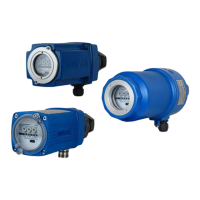8 | Flame monitor settings
D-LX 201/721
77
8.4 Setting the threshold for the flicker frequency
In addition to the standard switching threshold for the flame intensity (Fig.8.3) the
flame monitor also has the option of using different flicker frequencies of the flame and
the background radiation for the purpose of deciding between flame OFF and flame
ON.
The two switching threshold settings allow the firing plant commissioning engineer/op-
erator to make a decision as to which flame signal (Intens.) and which flicker fre-
quency of the flame (Freq.) should generate the flame ON or OFF notification.
NOTICE
Always disconnect the flame monitor before removing the cover.
If live printed circuit boards come loose from their plug connectors when removing the
cover, or
if removed printed circuit boards are re-connected under live conditions,
this will cause serious damage to the electronic components.
If printed circuit boards have come loose, always make sure that the plug connectors
for the printed circuit boards are not re-connected in the wrong order.
To set the switching threshold for the flicker frequency and to set the Modbus slave
address (optional), it is necessary for the cover to be completely removed (see section
7.4 Opening and closing the housing [}55]).
With MODE switches S3 and S4 (both on printed circuit board no. 2) you can select
various switch thresholds for the flicker frequency of the flame:
Fig.8.6: Printed circuit board no. 2, DIP switches S3 and S4
Switching threshold for frequency
(Hz)
Range A Range B
DIP position* 5 6 7 8
0** off off off off
25 on off on off
50 off on off on
75 on on on on
Table8.1: Switch for frequency and associated switch positions of MODE switches S3 and S4

